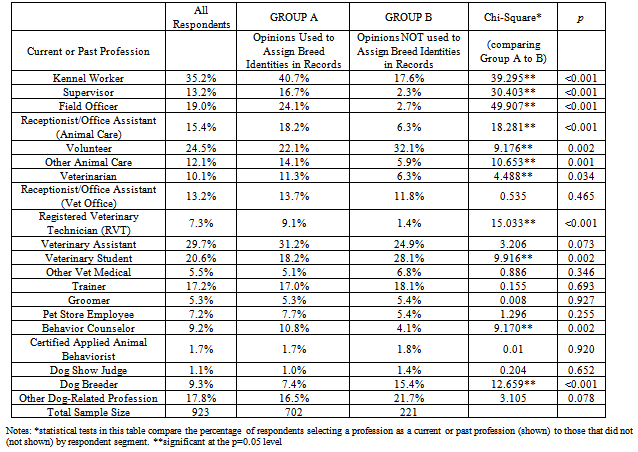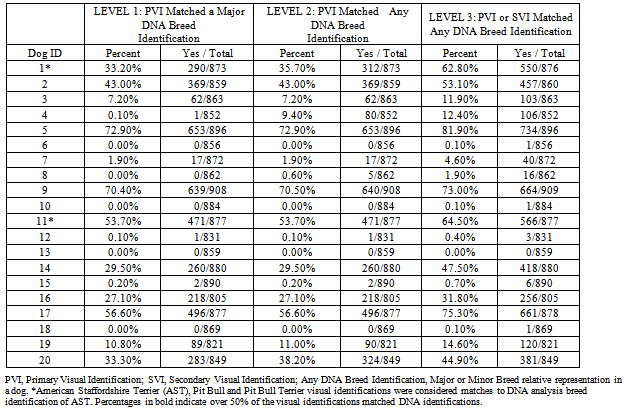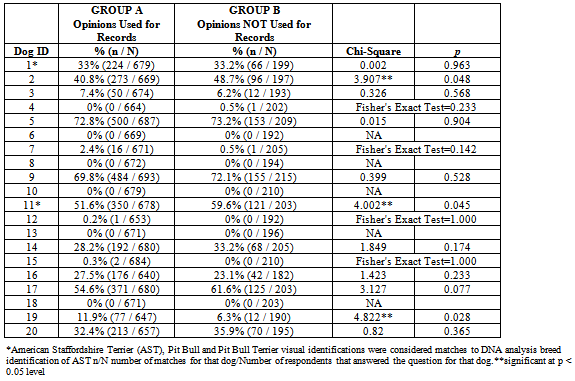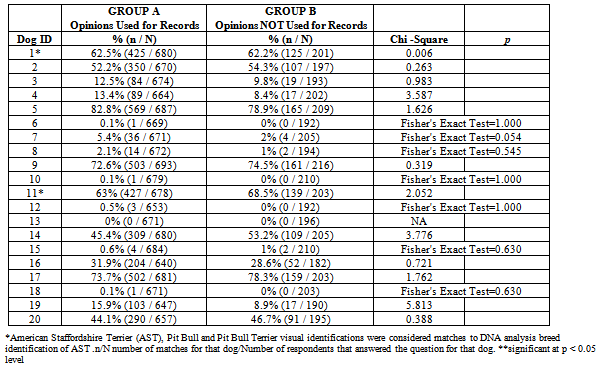-
Paper Information
- Next Paper
- Previous Paper
- Paper Submission
-
Journal Information
- About This Journal
- Editorial Board
- Current Issue
- Archive
- Author Guidelines
- Contact Us
American Journal of Sociological Research
p-ISSN: 2166-5443 e-ISSN: 2166-5451
2013; 3(2): 17-29
doi:10.5923/j.sociology.20130302.02
Comparison of Visual and DNA Breed Identification of Dogs and Inter-Observer Reliability
Victoria L. Voith1, Rosalie Trevejo2, Seana Dowling-Guyer3, Colette Chadik1, Amy Marder3, Vanessa Johnson1, Kristopher Irizarry1
1College of Veterinary Medicine, Western University of Health Sciences, Pomona, 91766, United States of America
2Oregon State University, Beaverton, 97006, United States of America
3Center for Shelter Dogs, Animal Rescue League of Boston, Boston, 02116, United States of America
Correspondence to: Victoria L. Voith, College of Veterinary Medicine, Western University of Health Sciences, Pomona, 91766, United States of America.
| Email: |  |
Copyright © 2012 Scientific & Academic Publishing. All Rights Reserved.
Until the recent advent of DNA analysis of breed composition, identification of dogs of unknown parentage was done visually, and visual identification is still the most common method of breed identification. We were interested in how often visual identification of dogs by people, assumed to be knowledgeable about dogs, matched DNA breed identification and how often these people agreed with each other (inter-observer reliability). Over 900 participants who engaged in dog related professions and activities viewed one-minute, color video-clips of 20 dogs of unknown parentage and were asked to identify the dogs’ predominant breeds. For 14 of the dogs, fewer than 50% of the respondents visually identified breeds of dogs that matched DNA identification. Agreement among respondents was also very poor. Krippendorf’s alpha was used to examine the reliability of the most predominant breed (selected across all dogs identified as mixed breeds) for all respondents, yielding alpha=0.23. For only 7 of the 20 dogs was there agreement among more than 50% of the respondents regarding the most predominant breed of a mixed breed and in 3 of these cases the most commonly agreed upon visual identification was not identified by DNA analysis.
Keywords: Inter-observer Reliability of Dog Breed Identification,Visual and DNA Identification of Mixed Breed Dogs
Cite this paper: Victoria L. Voith, Rosalie Trevejo, Seana Dowling-Guyer, Colette Chadik, Amy Marder, Vanessa Johnson, Kristopher Irizarry, Comparison of Visual and DNA Breed Identification of Dogs and Inter-Observer Reliability, American Journal of Sociological Research, Vol. 3 No. 2, 2013, pp. 17-29. doi: 10.5923/j.sociology.20130302.02.
Article Outline
1. Introduction
- The breed by which a dog is identified has important implications and ramifications. Breed identification is used in public health journals, veterinary medical records, lost and found notices, licensing documents and animal shelter descriptions. How a dog is identified also influences how people interpret a dog’s behavior. World-wide, public and private regulations and restrictions have been enacted that regulate dog ownership, euthanasia, availability of liability insurance, and access to housing. These rules may specify specific breeds, mixes of these breeds, or any dog that resembles these breeds. We were interested in how often visual identification of dogs by people assumed to be knowledgeable about dogs matched DNA breed identification, and how often these people agreed with each other (inter-observer reliability). Estimates of the prevalence of specific breeds of dogs that engage in injurious behaviors appear in numerous published articles related to public health, canine behavior, andveterinary medicine. Data concerning dog breeds, particularly pertaining to human injuries, are frequently tabulated from newspaper accountsor retrospective reviews of hospital and animal control records[1-10]. Sometimes dogs in these reports are identified by owners according to what they believe is the most predominant breed of their dog[4],[6],[9] or from information entered in veterinary medical records based on the staffs’ assessments[9],[11]. Generally, published reports supply no data on who identifiedthe dogs’ breeds[12]. Adding to the confusion, data are often published in a manner that combines dogs identified as purebreds with purebred crosses, e.g. the German Shepherd Dogand German Shepherd cross would bedepicted as German Shepherds[4],[7]; all dogs identified as pit bull breeds and pit bull hybrids would be categorized as a pit bull[10]. Although such publications may include cautionary statements that thebreed identifications were unverified, potentiallyinaccurate, and that data on the numbers and breeds of dogs in the source population were unknown[3-7], breed frequencies are still included in the publications. With the intention of providing public safety, regional and national governments have attempted to regulate dog ownership, how a dog is maintained, and impose euthanasia policies based on the perceived breed composition of a dog, be it a purebred or mixed breed[12-20]. Insurance premiums and housing restrictions are also based on a dog’s breed composition[8],[19],[20]. Until the recent advent of DNA analysis of breed composition[21-25] identification of dogs of unknown parentage was done visually, and visual identification is still the most common method of breed identification, even by law enforcement, animal care and control agencies, and veterinarians[19],[20],[26]. As examples, see the animal control ordinances of Prince George’s County Maryland, Denver Colorado, and Victoria, Melbourne Australia[27-29]. Our personal observations of discrepancies among people who attempt to visually identify the breed composition of dogs prompted this study. We were interested in how often visual identification by people assumed to be knowledgeable about dogs was in agreement with DNA identification, and how often people agreed with each other (inter-observer reliability). We felt this was important because of the potential ramifications of misclassification of dog breeds in published databases which drive public and private policies as well as people’s perceptions of the behavior of individual dogs.People who engage in professions or services that involve dogs are one source of identification of dogs of unknown parentage. They are in a position to provide their opinion to owners about the possible breed or predominant breed of their dogs. They may also directly assign a breed identity to dogs and enter their opinions on office forms and/or records. Either way, these identifications have the potential to be entered into national databases which are used for prevalence statistics on dogs’ breeds.
2. Methods
- The protocol for the study was approved by the Institutional Review Board and Institutional Animal Care and Use Committee of the Western University of Health Sciences, Pomona California.
2.1. Source of Participants
- The participants were recruited by contacting organizations involved in dog-related activities, such as veterinary medical groups, animal control/sheltering agencies, dog clubs, and regional and national conferences related to veterinary medicine and dog-related activities. Permission was requested to administer an anonymous, voluntary, dog breed identification quiz and survey (collectively referred to as the questionnaire), followed by an educational presentation. It was asked that the participants be at least 18 years old and able to understand and write English. At the time of the presentations, the participants were also informed that participation was anonymous, voluntary, could be discontinued at any time and that their responses were part of a research project. These sessions were administered in person, by either the Principle Investigator or a trained research assistant, at 30 locations in the following states: Arizona, California, Colorado, Louisiana, Massachusetts, Missouri, Ohio, Tennessee, Texas, Utah, and Washington. Many of these sites were at regional or national meetings with participants from several states.
2.2. Source of Dogs
- Twenty privately-owned dogs of unknown parentage were selected for the study from a pool of dogs that had been volunteered by their owners to participate in dog breed identification studies[26]. Forty of 50 volunteered dogs met the entrance criteria of being mature enough to have fully erupted canine teeth, having been obtained from a shelter, rescue, animal control or similar adoption agency, and being available on a specific day to be videotaped and have blood drawn. The 40 dogs were assigned to one of 4 weight ranges: ≤20 lbs. (9.07 kg), 21-40 lbs. (9.52-18.14 kg), 41-60 lbs.(18.60- 27.22 kg), and > 60 lbs. (27.22 kg). Five dogs were randomly selected from each weight range and entered into the study. The study dogs included 7 castrated males, 12 spayed females and 1 intact female. They had been adopted from 17 different locations in North America but currently residing in Southern California. Figure 1 depicts each study dog against a white screen with a black-lined grid of one-foot squares. The pictures are freezed frames from the videotapes that were shown to the participants. Detailed descriptions of each dog are provided Table 1.
 | Figure 1. Pictures of the 20 study dogs against a backdrop of 1 foot square grid of 1 foot squares |
|
2.3. DNA Analysis
- Two ml samples of heparinized blood from each dog were immediately refrigerated and sent on the same day on cold packs by overnight shipment to MARS VETERINARYTM Lincoln, Nebraska for DNA analysis. There were 130 American Kennel Club (AKC) registered purebreds in their database and the laboratory reported “an average of 84% accuracy in the first-generation crossbred dogs of known parentage”[22],[23]. Contributions of ancestral breeds less than 12.5% were not reported. The laboratory had in their database the AKC breed American Staffordshire Terrier but not any breeds identified as Pit Bull or American Pit Bull Terrier. Because of the common ancestry, historical reciprocal registrations, and similar morphology, we used visual identifications of American Staffordshire Terrier, Pit Bull, and American Pit Bull Terrier as matches to the DNA identification of American Staffordshire Terrier. For several years, the American Kennel Club (AKC) allowed dogs to be registered as Staffordshire Terriers (later changing the name to American Staffordshire Terrier) if the dogs were already registered as American Pit Bull Terriers in the United Kennel Club (UKC) or American Dog Breeders Association (ADBA) registries. Until 2010, the UKC permitted registration of AKC and ADBA dogs as American Pit Bull Terriers. AKC registered American Staffordshire Terriers are still allowed to be registered as American Pit Bull Terriers in the ADBA[30-33].We are not, however, suggesting that they are identical.For each dog, the breeds identified by DNA were classified as Major or Minor based on the relative percentage of the breed represented in that dog. Breeds reported at the highest percentage of DNA in a dog were classified as Major; breeds reported at lower percentages in that dog were classified as Minor. A dog could have more than one Major DNA breed identification, e.g., three breeds each represented at 25%. If only one breed was detected in a dog by DNA analysis, that breed was considered the Major breed, even if it was only 12.5% of the dog’s composition. Results of the DNA analyses of breed identification of each dog are in Table 1. None of the dogs were reported to be purebreds by DNA analysis.
2.4. Administration of Study Questionnaire
- Administration of the questionnaire and following educational program took about 55 minutes. The participants were shown one minute, color video-clips of each of the 20 dogs which were allowed to move about in front of a white screen with a black-lined grid of one-foot squares. Full bilateral and frontal views and a close up of the head were depicted. The participants were told the age, weight, and sex of each dog as they viewed the videos. After each video-clip, the respondents were given as much time as they requested to write in their answers. The video-clips were not re-shown. The respondents were required to generate their answers. They did not have access to resource materials and were asked not to solicit breed identifications fromeach other. In our experience, most dogs are often visually identified quickly as either a single breed or a single breed mix, generally without consulting resources. The video-clips were always shown the same order (Dog 1-20) which was the order that the owners, at their convenience, had brought their dogs to be videotaped.
2.5. The Survey and Quiz Questions
- Participants were asked to indicate: their current and past professional activities; if they now or ever have been asked what breed a dog appears to be; if their opinions have ever been used to assign possible breed identities for the purposeof records (e.g. shelters, medical, licensing, other businesses); and personal descriptive questions such as their age and sex, how many dogs they have, and if they have ever competed in any dog related activities, such as showing, agility, hunting, etc. For each dog, the respondents were asked: -“Do you think this dog is probably a purebred?” □ YES □ NO -“If YES, (you think this IS probably a purebred) What breed do you think it is?” -“If NO, (you do NOT think this a purebred) What do you think is the most predominant breed?” -“What do you think is the second most predominant breed. (If you are unable to determine a second breed, write “Mix” here. Otherwise, name a breed.)” In this article, identification as “not a purebred” is used synonymously with “mixed-breed”. The answer to the most predominant breed of a Mixed Breed is referred to as the Primary Visual Identification (PVI) and an answer to the second most predominant breed is referred to as the Secondary Visual Identification (SVI).Dogs of unknown parentage are generally designated by only one breed, e.g., Chow mix, German Shepherd mix[26]. We believe that when a dog is so identified, the assumption is that the named breed is the most predominant breed in the dog’s ancestry. Therefore, we wanted to know how often our respondents’ visual identification of the most predominant breed matched breeds identified at the highest percentage by DNA analysis. Secondarily, we were interested in whether or not a breed visually identified as the most predominant matched any breed identified by DNA, regardless of the percentage of DNA composition. And thirdly, we examined whether any visual identification, either the first or second breed identified, matched any percentage of DNA breed identified.
3. Results
- Nine hundred eighty six people completed all or part of a questionnaire. The questionnaires of 63 respondents were excluded from analysis for the following reasons: did not answer or answered “No” to the question “Are you now, or have you ever been asked what breed a dog appears to be.”; did not provide any information regarding their professions; or indicated they were less than 18 years old. Respondents were asked to indicate on the questionnaire if a specific dog was theirs or if they knew a dog’s DNA composition; data pertaining to these dogs were not included in the study, although data provided by the respondent pertaining to other dogs were included. All responses pertaining to a specific dog were tabulated, unless the answer was illegible.
3.1. Profile of Respondents
- Most respondents indicated involvement in more than one dog-related profession/service, either sequentially or simultaneously.The majority of respondents were or had been in animal control/sheltering and/or veterinary medical fields, see Figure 2.
 | Figure 2. Percent of 923 respondents engaged in each profession/service activity |
|
3.2. Comparison of Visual Identification and DNA Breed Identification
- The DNA analysis indicated none of the dogs were purebreds and most respondents identified the study dogs as mixed breeds. See Table 3. However, 7 of the 20 dogs were visually identified as probably purebreds by ten percent or more (range 10% - 25.4%) of the respondents. An average of 9.2 % (1701/18408) of the responses were “yes” to the question “Do you think this dog is probably a purebred?”.A positive match between visual and DNA identification occurred if (1) the respondent indicated that the dog was not a purebred and (2) also specified a breed identified by DNA.The following were NOT considered matched responses:if the dog was visually identified as a purebred (even if the breed identified was one identified as part of the dog’s composition by DNA analysis) OR if the dog was visually identified as not a purebred but identified as breed that was not reported by DNA analysis.For each dog, the percent of respondents whose visual identification matched the DNA identification was calculated by dividing the number of matched responses for a dog (numerator) by the sum of matched and unmatched responses (denominator). For each dog, we looked at how often visual and DNA identification matched at the three progressively less stringent levels:•Level 1: Respondent indicated that the dog was NOT a Purebred AND the most predominant breed (Primary Visual Identification/ PVI) matched at least one of the Major DNA Identifications for that dog.•Level 2: Respondent indicated that the dog was NOT a Purebred AND the PVI matched any DNA Identification (Major or Minor) of that dog.•Level 3: Respondent indicated that the dog was NOT a Purebred AND EITHER PVI or SVI (second most predominant breed) visual identification matched any DNA Identification of that dog. There were few significant statistical differences between those who had their opinions used for record keeping purposes (Group A) and those who did not have their opinionsso used (Group B) regarding the frequency with which visual and DNA identification matching occurred at any of the 3 levels of matching stringency. See appendix for comparisons of the two groups at the 3 levels of matching stringency. We concluded the few differences between groups A and B to be of no practical significance and combined the groups for subsequent analysis.
|
3.3. Inter-Observer Reliability of Visual Identification of Most Predominant Breed of Dogs Identified as Mixed Breeds
- Agreement among the respondents was also very poor, see Table 5 and see appendix. There was agreement among more than 50% of the respondents regarding the most predominant breed of a mixed breed for only 7 dogs and for 3 of these dogs the visual identification did not match any (either major or minor) DNA breed identification Krippendorff’s alpha was used to examine the reliability of the most commonly visually identified predominant breed (selected across all dogs identified as mixed breeds) for all respondents, yielding alpha=0.23 which is generally considered to represent low levels of inter-observer reliability[34],[35].The data was treated dichotomously, the respondents either provided the same answer (breed) or not.
|
|
4. Discussion
- This study reveals a wide disparity between DNA and visual identification of the predominant breeds comprising a dog. It also indicates a low level of agreement among people regarding breed composition. Those of us in the animal care services have always remarked on the differences of opinions regarding what breed a dog is but few are aware of how little agreement there is or how often one’s own opinion could be wrong.The wide range of responses by the participants are compatible with research and theories pertaining to judgments of probability based on partial information[36-42]. Identification of the breed composition of a dog requires recognition and recall, both of which are influenced by a multitude of variables, such as perception, knowledge base, memory, recent or salient experiences with the subject matter, and cognitive abilities involving categorization, sorting, matching and recombination of features.Identification is affected by what features (stimuli) a person notices and how much weight the person attributes to those features. For example, some people may attend to the hair coat and color pattern of a dog, while others focus on size, shape of head, or whether or not the tail is curled. The ease with which people notice a feature enhances recall and increases the weight that is placed on that feature. For example, so much significance is placed on any black pigmentation of a dog’s tongue that, regardless of the morphology of the dog, it is usually identified as a Chow Chow or Chow mix. The frequency with which people are exposed to the names of specific breeds of dogs and their perception of the population of specific breeds will also influence prediction. Interestingly, the literature indicates that well educated professionals are as susceptible to judgmental biases as are the lay public[36],[37],[43],[44].The low percentage of agreement between visual and DNA identification may be partially explained by perception biases. However, DNA identification of the proportion of purebred breeds in mixed breed dogs is not perfect either, nor do the laboratories that provide such analyses claim to be infallible. The average accuracy of identification of the breeds in an individual dog can be expected to decrease as the heterogeneity of its ancestors increases. Canine HeritageTM states that their accuracy of identification of known registered purebred dogs is 99%[45]. Wisdom PanelTM currently reports a 90% average accuracy of identification ofF1 crosses of known registered purebred dogs[46].After completing the quiz, the DNA results were revealed to the participants. However, it was not until we showed them pictures of the F1 and F2 crosses of registered purebred dogs[47] did the participants begin to realize that mixed breed dogs may not look like theirpurebred parents or grandparents. The mixed breeds bore little, if any resemblance, to their purebred parents or grandparents. Crosses of purebred dogs (particularly beyond the firstgeneration) can result in unique combinations and a collage of features.In fact, the pictures of Scott and Fuller’s dogs looked more like breeds other than their immediate ancestors. Many current breeds were derived by crossing existing breeds or by selecting for morphological variations within a breed until a “new” breed was established[25],[30]. It actually shouldn’t be surprising that visual identification of mixed breeds does not always agree with DNA based breed identification. A recent genetic study in dogs determined that very few regions of the canine genome encode morphological traits associated with breed-defining physical traits[48]. Dogs have on the order of 20,000 to 25,000 genes and fewer than 1% of the dog’s genes control the external morphological features associated with specific breeds of dogs, such as ear shape and size, whether the ears are floppy, length of the legs, length of the coat, coat color and shape of the head and length of muzzle. A dog could genetically be 50%a German Shepherd Dog and lack the genomic regions responsible for the German ShepherdDog size, coat color, muzzle length and ear properties.Even after Scott and Fuller’s pictures were shown, there was reluctance to consider that the DNA results might be correct. This is compatible with observations that people often adhere to their beliefs even when data is present that contradicts their beliefs and the confidence with which people adhere to these beliefs may actually increase when presented with contradictory data[36],[44],[49].Misidentification of a dog’s breed composition is not a trivial matter. How a dog is identified can affect many people and dogs. Dog ownership is common worldwide[50-53].In the United States approximately 40% of households have at least one dog,there is an increasing trend to obtain dogs from animal shelters/humane societies, and ownership of mixed breeds is increasing compared to purebreds[50],[51].
4.1. Limitations of the Study
- It is possible that the breeds of these 20 dogs in this study are unusually difficult to identify visually. Similar studies should be conducted with other samples of dogs and by other researchers.
5. Conclusions
- The disparities between visual and DNA identification of the breed composition of dogs and the low agreement among people who identify dogs raise questions concerning the accuracy of databases which supply demographic data on dog breeds, as well as the justification and ability to implement laws and private restrictions pertaining to dogs based on breed composition.
ACKNOWLEDGEMENTS
- We thank Elizabeth Arps, Dan Estep, John R. Greenwood, Janis Joslin, and Katherine Mitsouras for their help. The DNA breed analysis was provided by MARS VETERINARYTM Lincoln, NE 68501-0839. This study was partially supported by the National Canine Research Council, LLC, 433 Pugsley Hill Rd, Amenia, NY 12501.
APPENDIX
|
|
|
|
|
 Abstract
Abstract Reference
Reference Full-Text PDF
Full-Text PDF Full-text HTML
Full-text HTML








